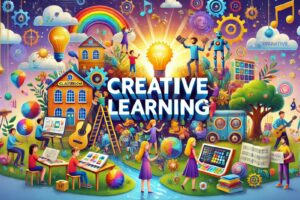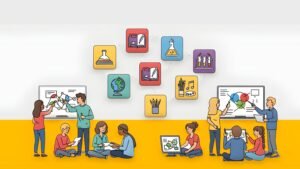The Importance of Digital Tools in Education
In contemporary educational settings, the integration of digital tools is paramount for enhancing the teaching and learning experience. As educational paradigms continue to evolve, the role of technology has become increasingly crucial. Digital tools have shifted how educators convey information and how learners engage with content, fostering an environment that emphasizes interactive and personalized learning. This transformation is evident in various facets of education, including curriculum design, assessment methods, and classroom management.
The incorporation of digital tools in teacher training programs is vital for several reasons. Firstly, these tools significantly improve learner engagement. Interactive platforms such as educational software or multimedia resources allow teachers to present information more dynamically, making lessons more appealing and interactive. This high level of engagement often leads to improved retention rates, as students find learning through digital mediums to be more stimulating and enjoyable.
Accessibility is another critical benefit of digital tool integration. In an increasingly diverse classroom, digital tools can accommodate various learning styles and needs. Technologies such as online resources, adaptive learning applications, and communication platforms allow teachers to deliver content that meets the unique requirements of each student. This ensures that all learners, regardless of their learning pace or style, have equal opportunities to receive quality education.
Finally, adopting digital tools in education enhances overall efficiency. Educators can utilize various forms of assessment and feedback, streamlining grading processes and providing timely insights into student progress. This efficiency allows teachers to dedicate more time to instruction and personalized educational support while leveraging technology to automate administrative tasks.
Current Digital Tools Used in Teacher Training
Digital tools have transformed the landscape of teacher training, facilitating more accessible, efficient, and interactive learning experiences. One of the most significant developments in this area has been the emergence of Learning Management Systems (LMS). Platforms such as Moodle and Canvas enable training institutions to deliver course content, track progress, and provide feedback seamlessly. These systems are designed to support a variety of pedagogical approaches while offering resources that are easily accessible to trainee teachers anytime and anywhere.
In addition to LMS, virtual classrooms have also gained prominence in teacher training. Tools like Zoom and Microsoft Teams have become essential for conducting live sessions, allowing trainee teachers to engage with instructors and peers in real time. These applications provide functionalities such as breakout rooms, screen sharing, and recording options, which promote interaction and collaboration among participants. The integration of virtual classrooms not only enhances the training experience but also prepares educators to use similar technologies in their future teaching capacities.
Assessment tools are another key component of the digital toolkit for teacher training. Platforms like Quizizz and Kahoot allow trainers to create interactive quizzes and assessments that make evaluating knowledge engaging. Such tools provide immediate feedback, enabling trainees to identify areas for improvement while also enhancing motivation through gamification. Moreover, analytics offered by these platforms can inform trainers about the effectiveness of their instruction methods.
Collaborative software also plays an instrumental role in teacher training. Applications like Google Workspace facilitate group projects and the sharing of resources, encouraging cooperative learning environments. By implementing these collaborative tools, training institutions foster essential skills such as teamwork and communication, which are crucial for future educators.
These digital tools, when strategically integrated into teacher training programs, not only enhance the efficacy of the training process but also empower future educators with the necessary technology skills for their careers.
Challenges in Integrating Digital Tools in Teacher Training
The integration of digital tools into teacher training programs presents various challenges that can hinder effective implementation. One prominent issue is the resistance from educators, who may be hesitant to adopt new technologies. This apprehension often stems from a lack of familiarity with the tools or a fear that such integration may disrupt their established teaching methods. Consequently, it is crucial for institutions to address these concerns through open dialogues and continuous encouragement of innovation.
Another significant barrier to integrating digital tools is inadequate training on new technologies. Many educators find themselves overwhelmed by the rapid pace of technological advancements, resulting in a gap between their skills and the demands of a digital classroom environment. This situation can hinder both educators’ and trainees’ ability to leverage tools effectively. Providing comprehensive professional development opportunities that focus on practical applications of digital tools is essential to empower educators and ensure smooth integration.
Furthermore, the lack of resources poses a formidable challenge in successfully adopting digital tools. Budget constraints often limit access to necessary equipment and technologies, making it difficult for institutions to provide adequate support for teacher training initiatives. Schools must prioritize funding for technology procurement and allocate resources strategically to enhance the infrastructure needed for successful implementation of digital resources.
Additionally, concerns about digital literacy among teacher trainees can further complicate the integration process. Not all trainees possess the same level of comfort or skill when using technology, which can lead to inequities in their learning experiences. To address this, institutions should implement assessments to gauge trainees’ digital literacy skills and tailor training programs accordingly, ensuring that all participants are prepared to utilize digital tools effectively.
Through understanding and addressing these challenges, educational institutions can pave the way for more successful integration of digital tools in teacher training programs, ultimately enhancing the overall quality of education.
Future Trends in Digital Tools for Teacher Training
The landscape of teacher training is continually evolving, with digital tools playing a pivotal role in enhancing the overall educational experience. As we look toward the future, several trends are likely to shape the integration of these technologies within teacher training programs. One prominent area of advancement is the utilization of artificial intelligence (AI). AI possesses the potential to tailor training experiences by analyzing individual educator performance and learning preferences. This personalization can lead to more effective training sessions, enabling teachers to develop pedagogical strategies that align with their specific needs and classroom environments.
In addition to AI, data analytics is expected to play an increasingly vital role in teacher training. Through the collection and analysis of performance metrics, educators can receive real-time feedback on their teaching methods. This can promote reflective practices, fostering an environment where teachers continuously refine their skills and adapt to the needs of their students. Metrics can highlight areas of strength and pinpoint opportunities for improvement, ultimately enhancing the overall effectiveness of the training process.
Another trend to watch is the rise of immersive technologies such as virtual reality (VR) and augmented reality (AR). These tools offer striking potential for creating engaging and interactive training environments. By simulating real classroom scenarios, VR and AR can enable teachers to practice their skills in a safe and controlled setting. This hands-on approach can foster confidence and competence, equipping educators with the necessary experience before stepping into a real-world setting.
Overall, as digital tools continue to progress, continuous adaptation and learning will be imperative for educators. Embracing these advancements can lead to improved teacher training outcomes, ensuring that educators are well-equipped to meet the challenges of modern classrooms. Staying abreast of these trends will enhance not only individual teaching practices but also the broader educational framework.






















